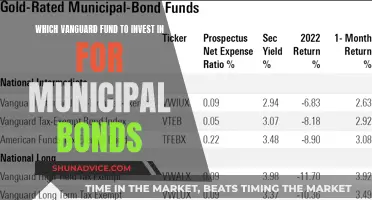
Investing in mutual funds is a great way to build a diversified portfolio without the hassle and high costs of investing in individual stocks and bonds. Mutual funds are a collection of investors' money that fund managers use to invest in stocks, bonds, and other securities. They are a good option for both beginners and experienced investors as they provide instant diversification and allow investors to target specific areas they believe will grow.
There are two main types of mutual funds: active and passive. Active funds are managed by professional investors with the goal of outperforming a market index, such as the S&P 500. Passive funds, on the other hand, are managed to track the performance of a market index and do not require an expensive investment team. While active funds may sound more appealing, passive funds have consistently outperformed them over long periods of time.
When investing in mutual funds, it is important to consider your financial goals, budget, and time horizon. You should also research the different types of funds available and compare their performance, fees, and investment strategies. It is also crucial to understand the risks involved and ensure that the fund's objectives align with your investment needs.
Mutual funds can be purchased through online brokers or directly from the fund manager. They typically have higher investment minimums than other asset classes and can only be bought and sold once a day after the market closes. This makes them more suitable for long-term investment goals rather than short-term trading.
| Characteristics | Values |
|---|---|
| Investment goals | Long-term goals, mid-term goals, near-term goals |
| Investment strategy | Active funds, Passive funds, target-date funds |
| Investment account | Standard brokerage account, 401(k), IRA, Roth IRA |
| Asset mix | Stocks, Bonds, Commodities |
| Investment research | Mutual-fund companies, fund screeners, fees, past performance, expense ratios, load fees, management |
| Investment amount | Minimum investment of a few thousand dollars |
| Investment timing | Buy and sell once a day at closing price |
| Investment style | Lump-sum, SIPs |
| Investment taxes | Capital gains tax, income tax, tax-advantaged accounts |
What You'll Learn

Understand the different types of mutual funds
There are several different types of mutual funds, each with its own investment focus and strategy. Here are some of the most common types:
Equity Mutual Funds
Equity mutual funds invest in stocks of publicly traded companies and account for more than half of the mutual funds on the market. They are designed to capture wider market gains but carry a higher risk of volatility in value. Equity funds can be further categorised based on company size, investment style, and geographic location.
Bond Mutual Funds
Bond funds are the second most common type of mutual fund. They invest in government and corporate debt, offering a safer investment option than equity funds, albeit with less potential for growth.
Money Market Mutual Funds
These funds are considered one of the safest investments, focusing on high-quality, short-term debt from governments, banks, or corporations. They are often used as a temporary holding place for cash and typically offer slightly higher returns than savings accounts.
Index Mutual Funds
Index funds have gained popularity in recent years due to the rise of passive investing strategies. They aim to replicate the performance of a specific market index, such as the S&P 500, by holding the same stocks in the same proportions. This passive approach often leads to better returns than actively managed funds.
Balanced or Hybrid Funds
Also known as asset allocation funds, these funds invest in a combination of stocks and bonds, maintaining a fixed ratio of investments. Target-date funds are a well-known variety of these funds, automatically adjusting the ratio of stocks and bonds over time.
Specialty or Alternative Funds
This category includes hedge funds, managed futures, commodities, and real estate investment trusts. Socially responsible mutual funds, which focus on funding companies with strong environmental and labour practices, are also gaining investor interest.
Co-Invest Funds: Higher Returns, Lower Risk?
You may want to see also

Set clear investment goals
Setting clear investment goals is a crucial step in investing in mutual funds. Here are some detailed instructions to help you set clear and effective investment goals:
Identify your financial objectives:
Ask yourself what you are investing for. Are you saving for retirement, buying a home, or funding your child's education? Determining your financial goals will help you choose the right investment strategies and products, including mutual funds.
Consider your time horizon:
Think about your investment timeframe. Are you investing for the short term or the long term? If you're saving for a goal that's less than three to five years away, you may be better off with more conservative investments, such as savings accounts or money market funds. For long-term goals, mutual funds can be a suitable option.
Assess your risk tolerance:
Determine how much risk you are comfortable taking. Can you handle dramatic swings in the value of your investments, or do you prefer a more conservative approach? Remember that risk and return are usually proportional, so consider your risk tolerance when setting your investment goals.
Choose the right type of mutual fund:
There are different types of mutual funds, such as growth funds, income funds, and balanced funds. Growth funds aim for capital appreciation and usually invest a large portion of their assets in stocks, making them riskier but offering potentially higher returns. Income funds focus on generating regular income by investing in bonds and other debt instruments. Balanced funds invest in both stocks and bonds, providing a mix of growth and income.
Set specific and measurable targets:
Define clear and measurable financial milestones. For example, you may aim to save a certain amount for a down payment on a house within the next five years. This will help you stay focused and motivated during your investment journey.
Review and adjust your goals periodically:
Investing is a dynamic process, and your circumstances may change over time. Regularly review your investment goals and make adjustments as needed. This may include changing your investment strategies, reallocating your portfolio, or setting new milestones.
Remember, setting clear investment goals is a crucial step in achieving your financial aspirations. It will help you make informed decisions, stay disciplined, and ultimately reach your desired outcomes.
Derivatives: A Mutual Fund's Strategic Investment Choice
You may want to see also

Research and compare funds
When researching and comparing mutual funds, there are several key factors to consider. These include the fund's fees, historical performance, investment strategy, and the company offering the fund.
Fees
One of the most important factors to consider when evaluating mutual funds is their fees. Mutual funds typically charge various fees, such as management fees, 12b-1 fees (covering marketing and selling expenses), and other administrative costs. The total fees can be expressed as an expense ratio, which is calculated as a percentage of your overall investment. It's essential to compare the expense ratios of different funds, as high fees can significantly reduce your investment returns over time.
Historical Performance
While past performance does not guarantee future results, examining a fund's historical performance can provide valuable insights. Look at the fund's performance over different time periods and in various market environments to assess its consistency and resilience. Remember that certain investment styles may fall in and out of favour, so a longer-term perspective is often more informative.
Investment Strategy
Mutual funds generally fall into two categories: active and passive. Active funds aim to outperform the market by employing professional fund managers who actively select investments. These funds tend to have higher fees due to the cost of research and management. On the other hand, passive funds aim to match the performance of a specific market index. They are more hands-off and have lower fees since they do not involve active management.
Fund Company
Researching the company offering the mutual fund is crucial. Look for well-known companies with a solid reputation and a track record of successful fund management. Check the company's website for regulatory filings and information about any issues or concerns. Some popular mutual fund companies include Vanguard, Fidelity, and American Funds.
By carefully considering these factors and comparing different mutual funds, you can make a more informed decision about which funds align with your investment goals, risk tolerance, and expected returns. Remember to read the fund's prospectus and understand all associated fees and risks before investing.
Covered Funds: A Smart Investment Strategy?
You may want to see also

Choose a brokerage account
If you already have a 401(k) or another employer-sponsored retirement account, you already have access to mutual funds. However, if you're investing for a goal outside of retirement, you'll need to open a brokerage account.
Brokerage accounts can be opened easily through an investment company or bank. When choosing a brokerage account, you should consider the following:
- Affordability: Mutual fund investors can face two types of fees: transaction fees from their brokerage account and expense ratios and front- and back-end "sales loads" from the funds themselves.
- Fund choices: Workplace retirement plans may carry only a small selection of mutual funds. If you want more variety, some brokers offer hundreds or even thousands of no-transaction-fee funds to choose from, as well as other types of funds like ETFs.
- Research and educational tools: With more fund choices comes the need for more research. It's important to pick a broker that provides resources to help you learn more about a fund before investing your money.
- Ease of use: You want to understand and feel comfortable with the brokerage's website or app.
Some of the best brokerage accounts for beginners include Fidelity and TD Ameritrade, while Vanguard is a popular choice for those investing directly with the fund company.
Vanguard Funds: Minimum Investment Requirements and Options
You may want to see also

Manage your portfolio
Once you have decided on the mutual funds you want to buy, you will need to think about how to manage your investment.
One move would be to rebalance your portfolio once a year, with the goal of keeping it in line with your diversification plan. For example, if one slice of your investments had great gains and now constitutes a bigger share of the pie, you might consider selling off some of the gains and investing in another slice to regain balance.
Sticking to your plan will also keep you from chasing performance. This is a risk for fund investors who want to get in on a fund after reading about how well it did the previous year. However, past performance is not indicative of future results. It is not a good strategy to hop from stock to stock based on performance. That is especially true with mutual funds, where each transaction may bring costs that erode any long-term gains.
Managing your portfolio also means managing your expectations, and different types of mutual funds should bring different expectations for returns. For example, stock mutual funds carry the highest potential rewards but also higher inherent risks, whereas bond mutual funds, which invest in a range of bonds, provide a more stable rate of return than stock funds.
Robinhood Index Fund Investing: A Beginner's Guide
You may want to see also
Frequently asked questions
A mutual fund is an investment vehicle that pools money from multiple investors to invest in securities such as stocks, bonds, commodities, and even real estate. Each share in the fund represents a proportional interest in the fund's portfolio. Mutual funds offer instant diversification and are managed by professionals, making them a good option for both beginner and experienced investors.
When choosing a mutual fund, consider your investment goals, risk tolerance, and the fund's investment objectives, performance, fees, and investment strategy (active or passive). It's also important to understand the fund's prospectus and the risks associated with the underlying assets.
You can buy mutual fund shares through online brokers or directly from the fund manager. Mutual funds are priced at the end of each trading day based on their net asset value (NAV). They have higher investment minimums than other asset classes, typically a few thousand dollars.
Yes, mutual funds typically charge management fees, 12b-1 fees (covering marketing and selling costs), and other administrative expenses. Some funds also charge load fees or commissions, which are paid to brokers when buying or selling shares. It's important to understand all the fees before investing.
Mutual funds make money by investing in securities on your behalf. They can generate income through interest or dividend payments, and appreciation in the value of the underlying securities. This appreciation can be reflected in the net asset value per share or distributed to investors as capital gains.







